
| Subject: | Information On Identifying Duramax™ Diesel LB7, LLY, LMM, LBZ Overpower Engine Breakdown or Non-Function Due to Aftermarket Power-Up Devices vs. Non Overpower Engine Non-Function of Pistons, Cylinders, and Valvetrain Components |
| Models: | 2001-2008 Chevrolet Silverado |
| 2003-2008 Chevrolet Kodiak |
| 2006-2008 Chevrolet Express |
| with Duramax™ 6.6L V8 Turbo Diesel Engine (VINs 1, 2, 6, D -- RPOs LB7, LLY, LMM, LBZ) |
This bulletin is being revised to add model years and to advise dealerships of additional service information on internal engine concerns using power-up devices. Please discard Corporate Bulletin Number 06-06-01-007 (Section 06 -- Engine/Propulsion
System).
General Motors Position On Aftermarket Power-Up Devices
Important: General Motors does not support or endorse the use of devices or modifications that, when installed, increase the engine horsepower and torque. Refer to bulletin number 04-06-04-054 -- Warranty Admin. - Non-GM Parts
and Accessories (Aftermarket).
Important: For further information on aftermarket power-up kits, refer to February 2006 Emerging Issues Course Number 10206.02D. In Canada, information on aftermarket power-up kits will be covered in the April 2006 TAC TALK program.
Aftermarket power-up devices are non-approved by General Motors. These devices are usually piggy-backed in the main engine harness or remain connected to the diagnostic connector to upload the calibration to the ECM. Recent warranty reviews of returned
engines show engine breakdown or non-function due to power-up devices that are utilized for increased horsepower and torque. The following information will assist technicians in identifying overpower engine breakdown or non-function due to aftermarket power-up
devices vs. non overpower engine breakdown or non-function.
Non-GM parts can alter the design of the vehicle. GM dealers need to be aware of the quality of parts being installed on vehicles. If failure occurs as a result of installation of sub-par parts, warranty coverage may be denied. Refer to Service Bulletin
Number 04-06-04-054
Warranty Admin. -- Non-GM Parts and Accessories (Aftermarket).
Installed Power-Up Kit
Aftermarket power-up kits have become a very popular add on for performance-minded customers. These devices can add horsepower and torque and can add additional stress to the engine. These aftermarket calibrations take the Duramax™ powertrain outside
of its design torque and horsepower rating. They do this by altering air/fuel ratios and injector timing, resulting in excessive cylinder pressure and temperature. When these calibrated parameters are altered, it will upset the design balance and can lead to
a reduction of engine life expectancy. Generally, in inspection of Duramax™ engine failure due to power-up failures, two or more cylinders will be affected.
Installed Power-Up Kit
| • | Once installed, the calibration may mask itself with the factory original calibration ID and may remain the same. |
| • | A Tech 2® will not positively enable you to identify the use of a power up device. |
| • | Some companies that offer power-up devices claim increases of 150 or more horsepower and 300 or more lb/ft pounds of torque. |
| • | A vehicle that is used to the power-up device potential 100% of the time will see earlier engine wear and breakdown. |
| • | A vehicle that takes advantage of additional power, but on a less frequent basis, may not see premature engine wear and breakdown until later in the engine's life. |
| • | A vehicle not pushed to its limits of the power-up device often may not encounter premature wear and breakdown until after the engine is out of warranty. |
Duramax™ Powertrain Horsepower / Torque Ratings
The following horsepower and torque increase over the past years required new internal components to accommodate the increase.
| • | LB7 - 300 hp with 520 ft/lb of torque for model years 2000-2004 |
| • | LLY -- 310 hp with 605 ft/lb of torque for model years 2004-2008 |
| • | LBZ -- 360 hp with 650 ft/lb of torque for model year 2006-2008 |
| • | LMM -- 365 hp with 660 ft/lb of torque for model year 2007-2008 |
LBZ Improvements
To reliably achieve an increase in 50 horsepower with 45 ft/lb torque, the Duramax ™ diesel had to be revised in many areas. A few of the revisions on the 2006 LBZ were:
| • | New pistons with a revised compression ratio. |
| • | Wrist pins that are larger in diameter. |
| • | Connecting rods with added material to increase the I section strength. |
| • | Engine block and machining changes. |
Duramax™ Life Expectancy
The Duramax™ 6.6L V8 Turbo Diesel Engine is sold with a warranty of 100,000 miles/160,000 kilometers. The Duramax™ has been tested to survive upwards of 200,000 miles/320,000 kilometers. The Duramax™ powertrain
is designed for reliability, peak horsepower and torque within its design limits. When a customer installs a power-up device, it drastically reduces the mileage ratings.
Important: Cylinder Wall Spotting (commonly referred to leopard spots) is from the induction hardening process of the top 1/3 of the cylinder wall. This is normal for the Duramax ™ Diesel.
Identifying Overpower Engine Premature Wear and Breakdown
When premature wear and breakdown is encountered due to an aftermarket power-up device, it has some very specific characteristics to the internal engine components. The following list will assist in identifying these characteristics as you tear down the
engine.
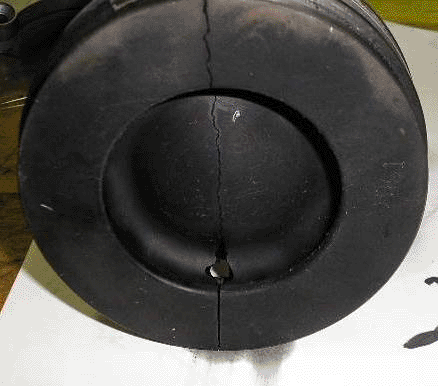
| • | Pistons will be cracked in the lip area, or a hole in the pistons. |
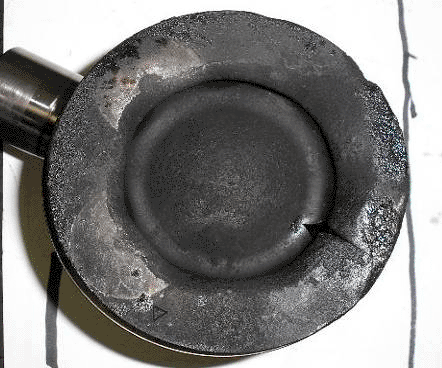
| • | Pistons can also be melted on the lip of the combustion bowl, or the top of the pistons can be melted. |
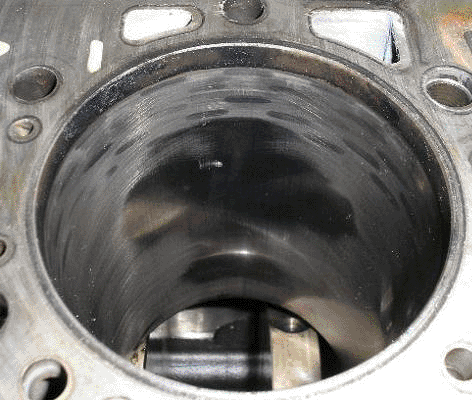
| • | Crosshatch will be polished off the cylinder wall in the major thrust face of cylinder below ring belt travel. |
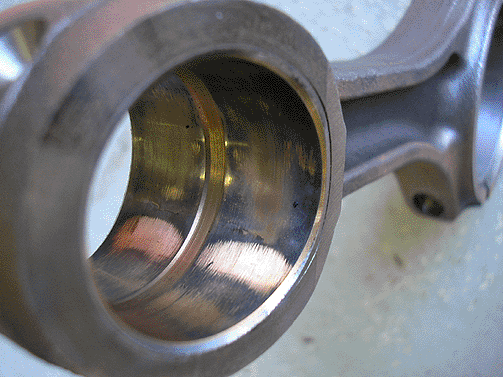
| • | Piston pin bore will show signs of scoring, the wrist pins will be discolored, and can have oil coking on them. The connecting rod bushing surface will have accelerated wear. The above illustration shows a connecting rod bushing. |

| • | Oil coking on the underside of the piston between the wrist pin bosses. |

| • | Signs of bearing fretting will also be noticed on the connecting rod and main bearing caps. Refer to the above illustration for fretting of main bearing cap 1 and back side of connection rod bearing 2. |
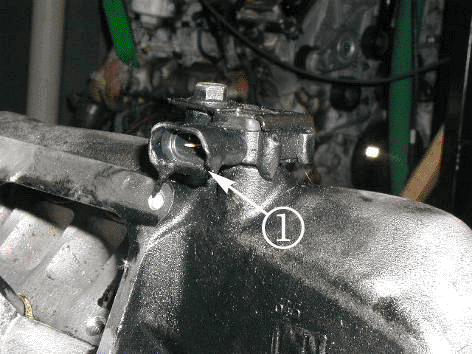
| • | Excessive heat in engine compartment caused by overpower device. Refer to above illustration (1). |
Non Overpower Engine Premature Wear and Breakdown
The following pictures show results of overheat, overspeed, low/no oil pressure or injector breakdown and how they differ from aftermarket power-up device premature wear and breakdown.
Engine Overheat
Overheat can be caused by a loss of coolant or a general cooling system failure. Some of the indicators of overheat are:
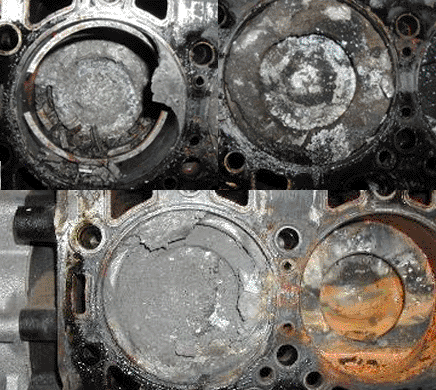
| • | Head gasket breakdown or non-function. |
| • | Crankshaft and connecting rod discolored. |
Engine Overspeed Causes
If an engine has been run faster that design capability (redline), and has caused damaged as a result, it may be a result of one of the following conditions:
| • | Leaking or failed turbo oil seals. |
| • | Oil evident in the intake runners and compressor side of the turbo. |
| • | Starting fluid use or alterative fuel added to the engine such as ether. |
Engine Overspeed Results
The following are indicators that an overspeed event took place:
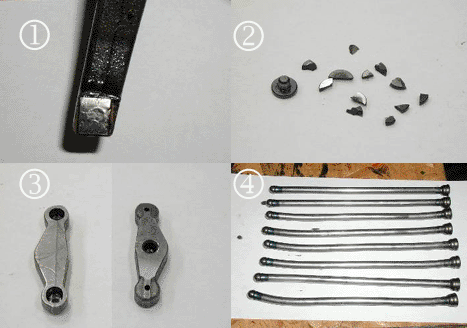
| • | Pushrods that are bent (4). |
| • | Broken valve bridge buttons after cylinder head removal (2). |
| • | Rocker arm tip damage (1). |
| • | Dry or rusted cylinders from the use of ether, propane or nitrous oxide. |
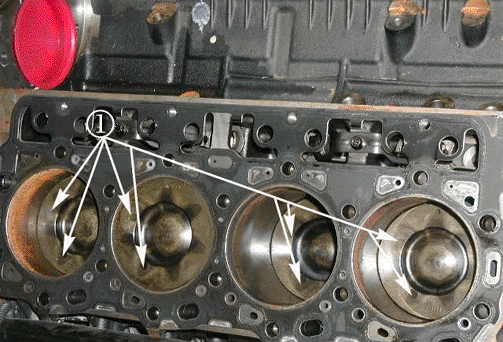
| • | Piston to valve contact. |
Lack of Oil Pressure
Lack of lubrication causes rapid bearing wear or bearing to seize.

Bearing failure. Spun main bearings.
Engine Premature Wear and Breakdown Due to Improper Function of Fuel Injector
A fuel injector may fracture a piston or melt a piston but the damage will be limited to that cylinder only and all other pistons and cylinder walls are OK. In some cases hydraulic lock will occur on the suspected cylinder with an over-fueling fuel injector.
Hydraulic lock on the suspected cylinder will cause a bent connecting rod. This can be verified with piston protrusion measurements.
Important: Copy aftermarket power-up kit check list when performing an engine disassembly investigation of overpower engine breakdown or non-function.
Aftermarket Power-Up Kit Check List
- Piston cracked parallel to wrist pin.
| • | Piston cracked in lip area. |
| • | Hole in piston connecting top of piston to oil cooling channel. |
- Melted Pistons.
| • | Lip of combustion bowl melted. |
| • | Top of piston melted / missing. |
- Cross hatching polished off cylinder wall. Cylinder wall missing crosshatch on major thrust face of cylinder below ring belt travel.
- Piston pin bore, Wrist pin, and Rod bushing.
| • | Scoring in upper piston pin boss/black discoloration/oil coking. |
| • | Rod bushing surface worn and discolored. |
- Carbon coking to underside of piston.
| • | Discoloration of underside of Piston. |
| • | Discoloration and carbon coking buildup on underside of piston between piston pin bosses. |
- Accelerated rod / Main Bearing wear.
| • | Fretting on backside of bearing. |
| • | Bearing surface distressed. |
How to handle an engine failure suspected due to a power up Device.
Dealers should not automatically decline warranty assistance on engine failures due to the fact that a power-up device or modification is evident or suspected. The technician must identify that the failure is due to a power-up device by teardown analysis
and diagnosis of the engine components. The following steps should be taken if an engine failure occurs and it is suspected that the modification or addition of a power-up device maybe the cause of the engine failure. If unclear of this process or direction
feel free to contact your District Service Manager (DVM) (in Canada, DSM) for further support.
- The technician should use proper engine diagnostics to lead him/her to the failed engine components. The attached check sheet should be followed and if it is determined that at least three of the check sheet items match the engine component failures
then it can be decided that the failure is not a warrantable claim.
- Engine failures that meet at least three criteria of the check sheet are considered failures that are not manufacturers defects in workmanship or materials
- The dealership should contact the PQC, open a case to review the findings and make the final decision on warranty coverage. The DVM (in Canada, DSM) should be notified of the PQC decision.
- Denied claims should be documented as follows:
a. The check sheet completed with the technicians detailed written findings of his diagnosis on the repair order.
b. Photographs of the failed parts should be maintained in the RO file.
- The customer should be advised that the failure of their engine was not due to a manufacturer's defect in workmanship or materials and therefore the warranty claim is denied on this failure.












